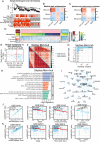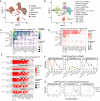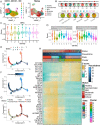A burns and COVID-19 shared stress responding gene network deciphers CD1C-CD141- DCs as the key cellular components in septic prognosis
- PMID: 37488118
- PMCID: PMC10366195
- DOI: 10.1038/s41420-023-01518-7
A burns and COVID-19 shared stress responding gene network deciphers CD1C-CD141- DCs as the key cellular components in septic prognosis
Abstract
Differential body responses to various stresses, infectious or noninfectious, govern clinical outcomes ranging from asymptoma to death. However, the common molecular and cellular nature of the stress responsome across different stimuli is not described. In this study, we compared the expression behaviors between burns and COVID-19 infection by choosing the transcriptome of peripheral blood from related patients as the analytic target since the blood cells reflect the systemic landscape of immune status. To this end, we identified an immune co-stimulator (CD86)-centered network, named stress-response core (SRC), which was robustly co-expressed in burns and COVID-19. The enhancement of SRC genes (SRCs) expression indicated favorable prognosis and less severity in both conditions. An independent whole blood single-cell RNA sequencing of COVID-19 patients demonstrated that the monocyte-dendritic cell (Mono-DC) wing was the major cellular source of SRC, among which the higher expression of the SRCs in the monocyte was associated with the asymptomatic COVID-19 patients, while the quantity-restricted and function-defected CD1C-CD141-DCs were recognized as the key signature which linked to bad consequences. Specifically, the proportion of the CD1C-CD141-DCs and their SRCs expression were step-wise reduced along with worse clinic conditions while the subcluster of CD1C-CD141-DCs from the critical COVID-19 patients was characterized of IFN signaling quiescence, high mitochondrial metabolism and immune-communication inactivation. Thus, our study identified an expression-synchronized and function-focused gene network in Mono-DC population whose expression status was prognosis-related and might serve as a new target of diagnosis and therapy.
© 2023. The Author(s).
Conflict of interest statement
The authors declare no competing interests.
Figures






Similar articles
-
Acute aerobic exercise induces a preferential mobilisation of plasmacytoid dendritic cells into the peripheral blood in man.Physiol Behav. 2018 Oct 1;194:191-198. doi: 10.1016/j.physbeh.2018.05.012. Epub 2018 May 31. Physiol Behav. 2018. PMID: 29763678
-
Human CD141+ Dendritic Cell and CD1c+ Dendritic Cell Undergo Concordant Early Genetic Programming after Activation in Humanized Mice In Vivo.Front Immunol. 2017 Oct 30;8:1419. doi: 10.3389/fimmu.2017.01419. eCollection 2017. Front Immunol. 2017. PMID: 29163495 Free PMC article.
-
Increased tubulointerstitial recruitment of human CD141(hi) CLEC9A(+) and CD1c(+) myeloid dendritic cell subsets in renal fibrosis and chronic kidney disease.Am J Physiol Renal Physiol. 2013 Nov 15;305(10):F1391-401. doi: 10.1152/ajprenal.00318.2013. Epub 2013 Sep 18. Am J Physiol Renal Physiol. 2013. PMID: 24049150
-
Human CD141+ (BDCA-3)+ dendritic cells (DCs) represent a unique myeloid DC subset that cross-presents necrotic cell antigens.J Exp Med. 2010 Jun 7;207(6):1247-60. doi: 10.1084/jem.20092140. Epub 2010 May 17. J Exp Med. 2010. PMID: 20479116 Free PMC article.
-
Primary Human Blood Dendritic Cells for Cancer Immunotherapy-Tailoring the Immune Response by Dendritic Cell Maturation.Biomedicines. 2015 Dec 2;3(4):282-303. doi: 10.3390/biomedicines3040282. Biomedicines. 2015. PMID: 28536413 Free PMC article. Review.
References
LinkOut - more resources
Full Text Sources
Research Materials
Miscellaneous

